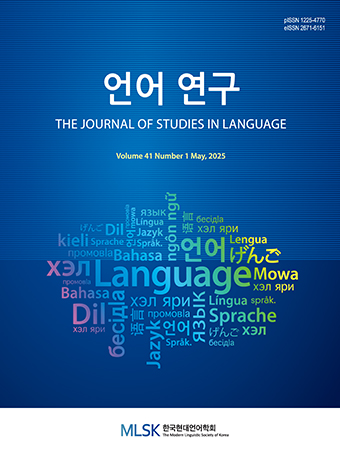Research Article
Abstract
References
Information
This research aims to investigate the effects of telephone English conversation class as a medium, which provides adult Korean EFL learners with one‒to‒one conversations with English native speakers. This research examines the effects of these conversations on the EFL learner’s speaking performance in terms of the CAF(Complexity, Accuracy, and Fluency). This is a case study about a Korean advanced EFL learner who participated in conversations with English native speakers through phone call for five months. The conversations between the teacher and the learner were transcribed and the changes in the learner’s utterances were quantitatively analyzed. The result showed that the degree of complexity and the fluency of the learner’s speaking increased during the period. The learner produced longer and more complex sentences with multiple clauses. Also, the learner made more utterances as a result of participating in more telephone English conversations. On the other hand, the degree of the accuracy of speaking has decreased and the accurate use of verb forms abided by tense and agreement rules showed no shift in terms of L2 language development. (University of Seoul)
- 남주연·김영주. 2015. 한국어 학습자의 구어 산출에 나타난 통사 복잡성 발달. 한국어교육, 26.1: 59-87.
- 박은영. 2003. 원어민과의 전화영어 회화 학습이 중학교 영어 학습자의 구두 의사소통 능력 및 정의적 측면에 미치는 영향. 이화여대 교육대학원 석사학위논문.
- 박은영. 2012. 전화영어회화 방법을 이용한 사이버대학 영어회화 수업. 인문논총, 30: 293-315.
- 재경일보. 2012. 1. 25. 전화와 영상을 통해 영어를 배우는 시대. http://news.jkn.co..kr/article/news/20120125/4283061.htm
- 정숙경. 2012. 전화 영어 수업 분석과 영어 말하기 능력 증진 효과에 대한 연구. Journal of Linguistic Studies, 17.3: 69-88.
- 조선·신동일. 2014. 전화영어에 나타난 대화의 특성 연구: 상호작용 담화모형의 관점에서. 영어학, 14.4: 603-631.
- 지방행정신문. 2018. 5. 28. 경기도, 교육복지 실현 영어 교육격차 해소 프로젝트 추진. http://www.localadmininews.com/1488
- 충청일보. 2018. 7. 12. 일대일영어회화 과외학습, 스카이프전화, 화상영어 고화질 선보여 http://www.ccdailynews.com/news/articleView.html?idxno=971635
- Ellis, R. 2003. Task-Based Language Learning and Teaching. Oxford: Oxford University Press.
- Fillmore, C. J. 1979. On Fluency In C. J. Fillmore, D. Kempler and W. S. Y. Wang (eds.), Individual Differences in Language Ability and Language Behavior (pp. 85-102). New York, NY: Academic Press.10.1016/B978-0-12-255950-1.50012-3
- Foster, P., Tonkyn, A., and Wigglesworth, G. 2000. Measuring Spoken Language: A Unit for All Reasons. Applied Linguistics, 21, 354-375.10.1093/applin/21.3.354
- Kormos, J., and Dénes, M. 2004. Exploring Measures and Perceptions of Fluency in the Speech of Second Language Learners. System, 32, 145-162.10.1016/j.system.2004.01.001
- Kim, K. 2012. Phone-Based Interaction and Development of L2 Oral Fluency. English Language and Literature Teaching 18.4: 51-70.
- Kim, K. 2012. L2 Phone-Based Interaction (PBI) and Development of Communicative Competence: A Case Study of an Adult’s English Learning in EFL Context. Asian EFL Journal, 14, 99-177.
- Kuiken, F., Vedder, I., and Gilabert, R. 2010. Communicative Adequacy and Linguistic Complexity in L2 Writing. In I. Bartning, M. Martin, and I. Vedder (eds.). Communicative Proficiency and Linguistic Development: Intersections between SLA and Language Testing Research (pp. 81-100). Eurosla Monograph Series, Vol. 1.
- Kusyk, M. 2017. The Development of Complexity, Accuracy and Fluency in L2 Written Production through Informal Participation in Online Activities. CALICO Journal (Online) 34.1: 75-96.10.1558/cj.29513
- Lennon, P. 2000. The Lexical Element in Spoken Second Language Fluency. In H. Riggenbach (Ed.), Perspectives on Fluency (pp. 25-42). Ann Arbor: The University of Michigan Press.
- Lintunen. P. and Makila, M. 2014. Measuring Syntactic Complexity in Spoken and Written Learner Language: Comparing the Incomparable? Research in Language, 12.4, 377-399.10.1515/rela-2015-0005
- Norris, J. M., and Ortega, L. 2009. Towards an Organic Approach to Investigating CAF in Instructed SLA: The Case of Complexity. Applied Linguistics, 30, 555-578.10.1093/applin/amp044
- Ortega, L. 2003. Syntactic Complexity Measures and Their Relationship to L2 Proficiency: A Research Synthesis of College-Level L2 Writing. Applied Linguistics, 24, 492-518.10.1093/applin/24.4.492
- Polio, C. 1997. Measures of Linguistic Accuracy in Second Language Writing Research. Language Learning, 47.1, 101-143.10.1111/0023-8333.31997003
- Segalowitz, N. 2000. Automaticity and Attentional Skill in Fluent Performance. In H. Riggenbach. (ed.), Perspectives on Fluency (pp. 200-219). Ann Arbor: University of Michigan Press.
- Skehan, P. and Foster, P. 1999. The Influence of Task Structure and Processing Conditions on Narrative Retellings. Language Learning, 4.1, 93-120.10.1111/1467-9922.00071
- Skehan, P. 2009. Modeling Second Language Performance: Integrating Complexity, Accuracy, Fluency, and Lexis. Applied Linguistics, 30.4, 510-532.10.1093/applin/amp047
- Skehan, P. and Foster, P. 2012. Complexity, Accuracy, Fluency and Lexis in Task-Based Performance. In Housen, A, Vedder, I, Kuiken, F. (eds.), Dimensions of L2 Performance and Proficiency: Complexity, Accuracy and Fluency in SLA (pp. 199-220). Amsterdam: John Benjamins Publishing Company.10.1075/lllt.32.09fos
- Tavakoli, P., Campbell, C., and McCormack, J. 2016. Development of Speech Fluency over a Short Period of Time: Effects of Pedagogic Intervention. Tesol Quarterly, 50.2, 447-471.10.1002/tesq.244
- Tonkyn, A. 2012. Measuring and Perceiving Changes in Oral Complexity, Accuracy and Fluency. In Housen, A, Vedder, & I, Kuiken, F. (eds.), Dimensions of L2 Performance and Proficiency: Complexity, Accuracy and Fluency in SLA (pp. 222-245). Amsterdam: John Benjamins Publishing Company.
- Yuan, F. and Ellis, R. 2003. The Effects of Pre-Task Planning and On-Line Planning on Fluency, Complexity and Accuracy in L2 Monologic Oral Production. Applied Linguistics, 24.1, 1-27.10.1093/applin/24.1.1
- Publisher :The Modern Linguistic Society of Korea
- Publisher(Ko) :한국현대언어학회
- Journal Title :The Journal of Studies in Language
- Journal Title(Ko) :언어연구
- Volume : 34
- No :3
- Pages :363-376
- DOI :https://doi.org/10.18627/jslg.34.3.201811.363




 The Journal of Studies in Language
The Journal of Studies in Language






